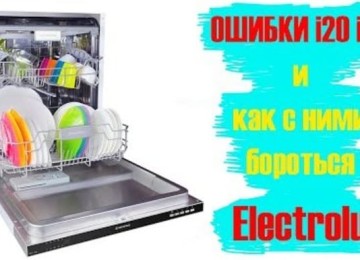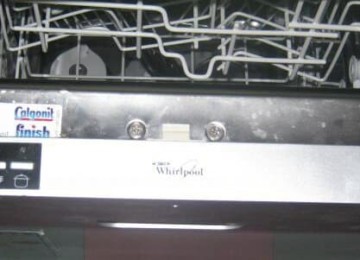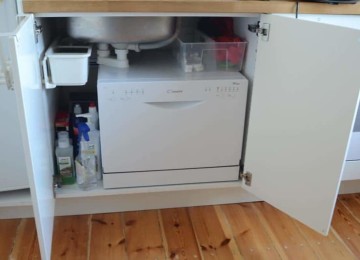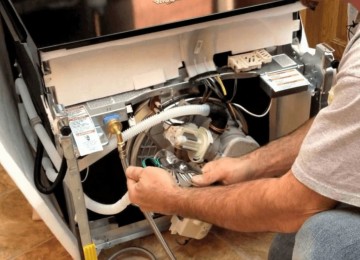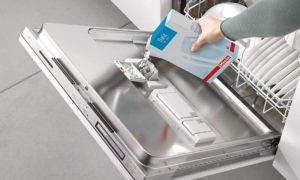 A dishwasher is a fairly large purchase; usually before this, people spend a long time choosing equipment, comparing technical characteristics and reading reviews about household appliances produced by different companies. Correctly selected machine characteristics are very important. You may have checked the equipment in the store, but while it is being delivered to you, some malfunctions may arise in it. Or there may be a defect in the product that appeared during production.
A dishwasher is a fairly large purchase; usually before this, people spend a long time choosing equipment, comparing technical characteristics and reading reviews about household appliances produced by different companies. Correctly selected machine characteristics are very important. You may have checked the equipment in the store, but while it is being delivered to you, some malfunctions may arise in it. Or there may be a defect in the product that appeared during production.
Therefore, it is important to carry out the first run of the dishwasher, which is also called a test run. If you have purchased a model that needs to be built into kitchen furniture, you should not install the machine until a test run is completed so that you can see all the flaws, if any, and notice any leaks.
What do you need to know before using your dishwasher for the first time?
The first test run is needed to remove industrial contaminants remaining on the inner surface of the machine.In addition, there may be traces of the hands of customers and store employees who inspected the product before you, dust and fine dirt, as well as residues of chemical contaminants. Therefore, you should not neglect the test run.
Many dishwashers are equipped with special test strips to determine the hardness level of your tap water. This data must be manually entered into the machine so that it can automatically determine the required salt intake. The salt concentration in the device is regulated by special sensors. If it is below the minimum, then you need to replenish the salt supply in a special compartment.
Dishwasher safety precautions
Each dishwasher has special instructions for use, developed specifically for this model. Do not neglect reading this document, because it contains the main points that need to be taken into account during operation: the number of machine programs, required care, the function of the machine independently determining the type of detergent or the need to manually specify this parameter. If you rush and start using the dishwasher right away, many operational problems may arise in the future: from breakdowns as a result of improper starting on the first day to premature wear of the working parts of the dishwasher during its use.
Dishwasher testing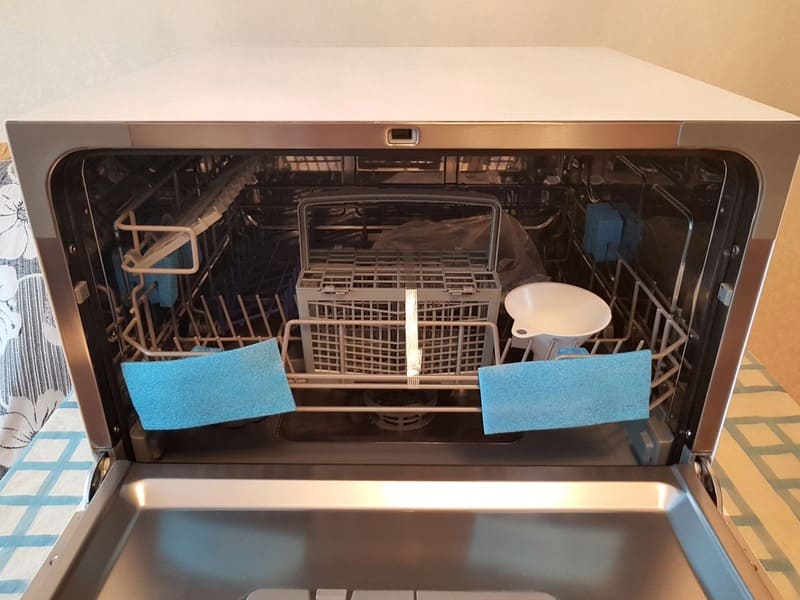
Before starting, you need to determine the water hardness using special test strips. They may come included, or you may need to purchase them separately.
Things to check during a test run:
- Uninterrupted water supply.Is there any delay during the process, is water supplied throughout the entire cycle.
- Heating water to the required temperature. To do this, turn on the most powerful mode to see if the heating elements are working well.
- Complete drainage of water, without delays. Does water remain in the machine after draining? Are all elements of the system working well?
- Lack of water inside the machine after the end of the process. Here the dish drying system, air supply and heating elements are checked.
Preparing for the first launch
Before the test run, it is necessary to inspect the machine for defects on the external panel and inspect the interior of the dishwasher. There may be small debris, Styrofoam balls or packaging material left behind. Remove unnecessary stickers. Be sure to open the faucet to allow water to enter the dishwasher, otherwise it will not be possible to start.
Don’t forget to check the level position of the standing machine and check how freely the nozzles are installed. Also remove and rinse the filter under tap water. Make sure all hoses are connected correctly and the unit is connected to electricity. For the first start, it is better to choose a high-intensity mode for cleaning dishes.
How to turn on the dishwasher
If this is your first time encountering this technique, it is better to follow the following sequence of actions:
- Make sure all hoses are connected correctly.
- Rotate the sprayer inside the chamber several times: this way you will understand whether it is well secured and rotates freely.
- Remove, wash and reinstall the drain filter.
- Select the appropriate cleaning products and fill the required containers with them.
- Set the longest wash program with the highest temperature to check all functions and possible malfunctions.
- Close the dishwasher door tightly and press the start button.
- Follow the process, but if something does not go according to plan, do not try to interfere and improve something during the dishwashing process, wait until the end.
- Check the quality of drainage, drying, heating and water supply.
Test run tools
Even though there are no dishes inside the machine when you first start it, you will still need cleaning products. Including treating the machine itself from the inside so that there is no dirt or harmful compounds left in it, which could then end up on your dishes. There are containers on the back of the dishwasher door that are designed to hold detergents.
You will need special salt to soften the water, The dishwashing liquid itself. Another option is to use a universal dishwasher tablet, which combines several functions at once. However, even in this case, when starting for the first time, it is better to use specialized salt. The salt will need to be poured into the desired compartment (400 or 500 grams), then add 1000 ml of water there.
The dishwashing liquid itself. Another option is to use a universal dishwasher tablet, which combines several functions at once. However, even in this case, when starting for the first time, it is better to use specialized salt. The salt will need to be poured into the desired compartment (400 or 500 grams), then add 1000 ml of water there.
The compartment for placing salt in the machine is located at the bottom and is closed with a lid. Don't forget to use the buttons on the panel to indicate the type of detergent.
Detergent powder must be loaded in portions. Unfortunately, not all dishwashers are equipped with a sensor that measures the level of solution in the basket. Therefore, it is important to put the required amount of the product prescribed in the instructions.The same difficulty arises with rinse aid: simpler machines require a portion of rinse aid to be poured in before starting each dishwashing program; In more modern machines, it is possible to pour in a reserve of rinse aid; the machine uses it as needed.
Sometimes housewives are tempted to use regular table salt instead of a specialized product. But doing this is undesirable and even dangerous for two reasons:
- Firstly, there is a difference in composition. The composition of ordinary table salt, in addition to sodium chloride, contains additional elements and additives necessary in the food industry, which have an extremely negative effect on the operation of equipment.
- Secondly, the difference is in the format. Specialized salt has larger granules than regular table salt. Thanks to this, it dissolves and performs its function much longer.
Failure on first launch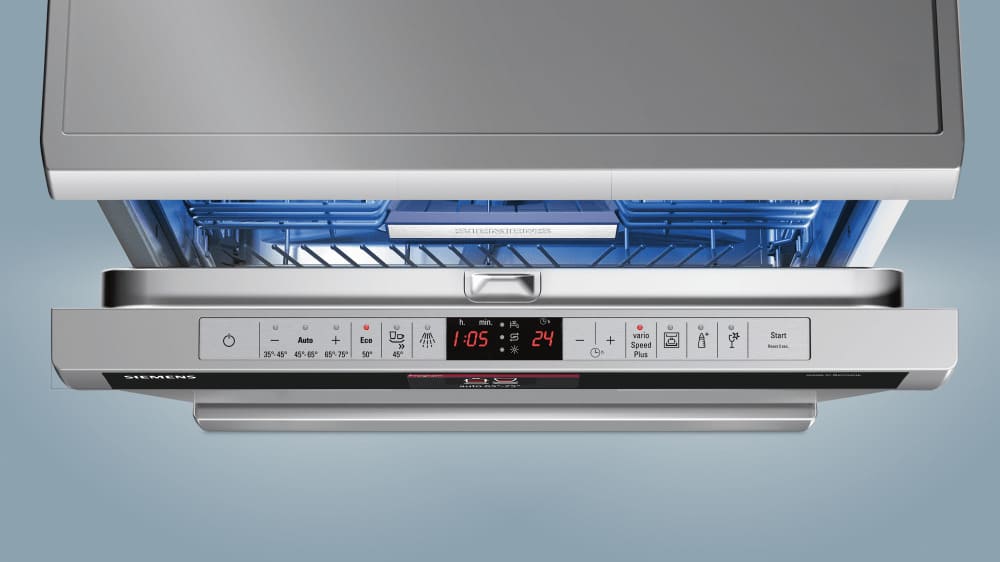
It happens that problems arose during a test run. But that’s why it’s a trial, to identify and fix problems in advance. Let us remind you once again that before starting it is necessary to study the instructions for use in order to avoid damage to the mechanism due to the incorrect sequence of actions:
- The filter is clogged or the hose is kinked. Some of the simplest problems that you can easily fix yourself. Ideally, it is better to check all hoses before starting the machine for the first time;
- If an error code appears on the panel, lights flash or warning signals are emitted, the instructions again save the day. Find the error code that appears on the display and try to fix the problem. If the problem cannot be solved, contact a technician or the warranty department of the store that sold you the household appliance;
- The machine's operating program froze in the middle. Most likely, the reason for such a stop is an electronic failure. An old, reliable trick can help here: unplug the washing mashine from the power for ten to fifteen minutes and try to turn it on again. If this method does not help, you will need technical support;
- the appearance of light or dark smoke, the smell of burnt plastic. In this case, immediately unplug the machine's power cord from the power source. This option indicates major malfunctions of the machine, perhaps even incorrect assembly of the device. Here you should not try to solve the issue yourself; it is better to immediately seek help from professionals.
Important! When purchasing household appliances, be sure to familiarize yourself with the terms of warranty service and the conditions for obtaining professional assistance.
Getting started with your dishwasher
Operation begins only after a test run and all problems have been corrected. You should not try to use the machine right away without checking it, because this can harm your health and damage your household appliances. After the first start, the dishwasher must cool down and dishwashing detergent must be added to the correct containers.
Before you begin to fully use the machine, it is important to allocate enough time to understand the issues of servicing household appliances, choosing the appropriate detergent and safe operation of the machine itself in order to avoid rapid breakdown, wear of machine parts and to extend the life of this type household appliances.
How to choose dishwashing detergents
The right choice of dishwashing detergent is one of the main factors for the long operation of your household appliances. Modern dishwashing detergents in the dishwasher combine several functions. In addition to directly washing dishes, they prevent the appearance of scale, solve problems with water hardness and clean the dishwasher itself. It happens that a manufacturer recommends a certain brand of detergent for its products. If this is not your case, then here is what you should pay attention to when choosing a detergent:
- release form. It comes in powder, gel or tablet.
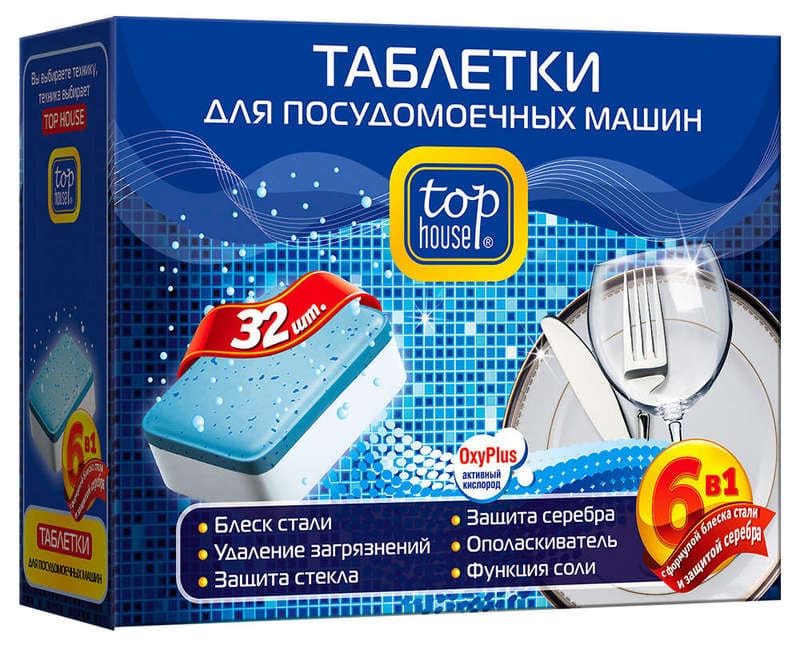 The difference between them is in cost, quality of washing dishes and ergonomics of consumption;
The difference between them is in cost, quality of washing dishes and ergonomics of consumption; - detergent composition. The composition corresponds to the degree of contamination and the material from which the dishes are made. Each active substance in it performs its own function, so it is important to choose the right product according to your needs;
- aggressiveness of the detergent. This is especially true for allergy sufferers and families with small children. Aggressive agents wash dishes better, but can be dangerous and cause a severe allergic reaction. In this case, it is better to choose weaker but hypoallergenic detergent compositions.
In addition to direct detergents, when operating a dishwasher you will need additional products to soften water, remove scale from heating elements of equipment and clean the dishwasher.
Often the active ingredient in detergents is chlorine and its derivatives. They thoroughly clean dishes, have an antibacterial effect and keep dishes white. You cannot wash dishes with patterns or unstable coatings using these products.Recently, enzymes have been a good alternative to chlorine for more delicate cleansing. They are less allergenic, work well in cold water and are gentle on dishes. The only thing is that you cannot expect such a pronounced bleaching effect as with chlorine.
For allergy sufferers, products marked “eco” are suitable. They contain only natural ingredients, but their cleaning ability is lower than that of products with chlorine and enzymes. There may be greasy stains on the dishes and the machine, so you will need more detergent to clean the machine.
Detergents are divided into regular and combined. The former should be used together with water softeners and rinse aids. Therefore, with high cleansing results, you need to constantly monitor the consumption of funds and fill the necessary containers on time. Combined products are suitable for those who love simplicity in everything. They combine several functions, however, due to this they are more expensive.
Selecting a washing program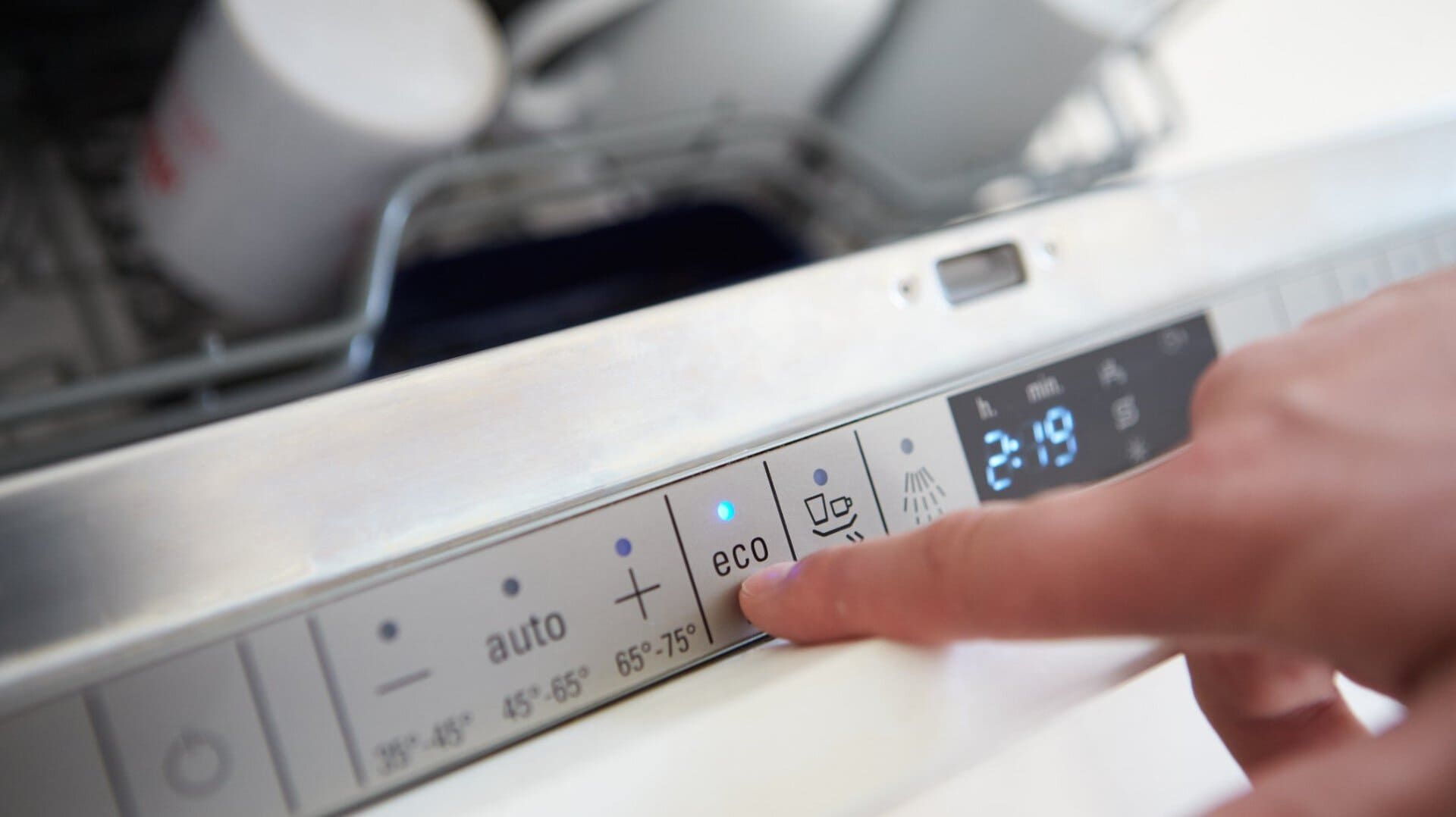
The set of programs in each machine is usually standard, but they have different names. Therefore, finding the right one can be a little more difficult. The program depends on the degree of contamination and your preferences:
- preliminary or main soaking. This mode is needed for complex stains, burnt food or fat;
- High-intensity cleaning is needed for dishes with complex stains, but without the absence of burnt particles. Not suitable for sensitive dishes because cleaning is done with hot water, which can damage the delicate coating;
- Standard cleaning is suitable for everyday dishwashing. Provides high-quality cleaning with low energy consumption;
- Economy mode uses cold water, so it is suitable for lightly soiled dishes;
- delicate mode is intended for dishes with sensitive coatings or glass;
- quick cleansing. This mode simply rinses the dishes with rinse aid and then with plain water. Does not imply either drying or strong washing of dishes.
Be sure to check the quality of dishwashing after the first start. If you find streaks on the dishes, add rinse aid. If the dishes remain dirty, you need to change the program to a more effective one or add detergent.
How to load the cart correctly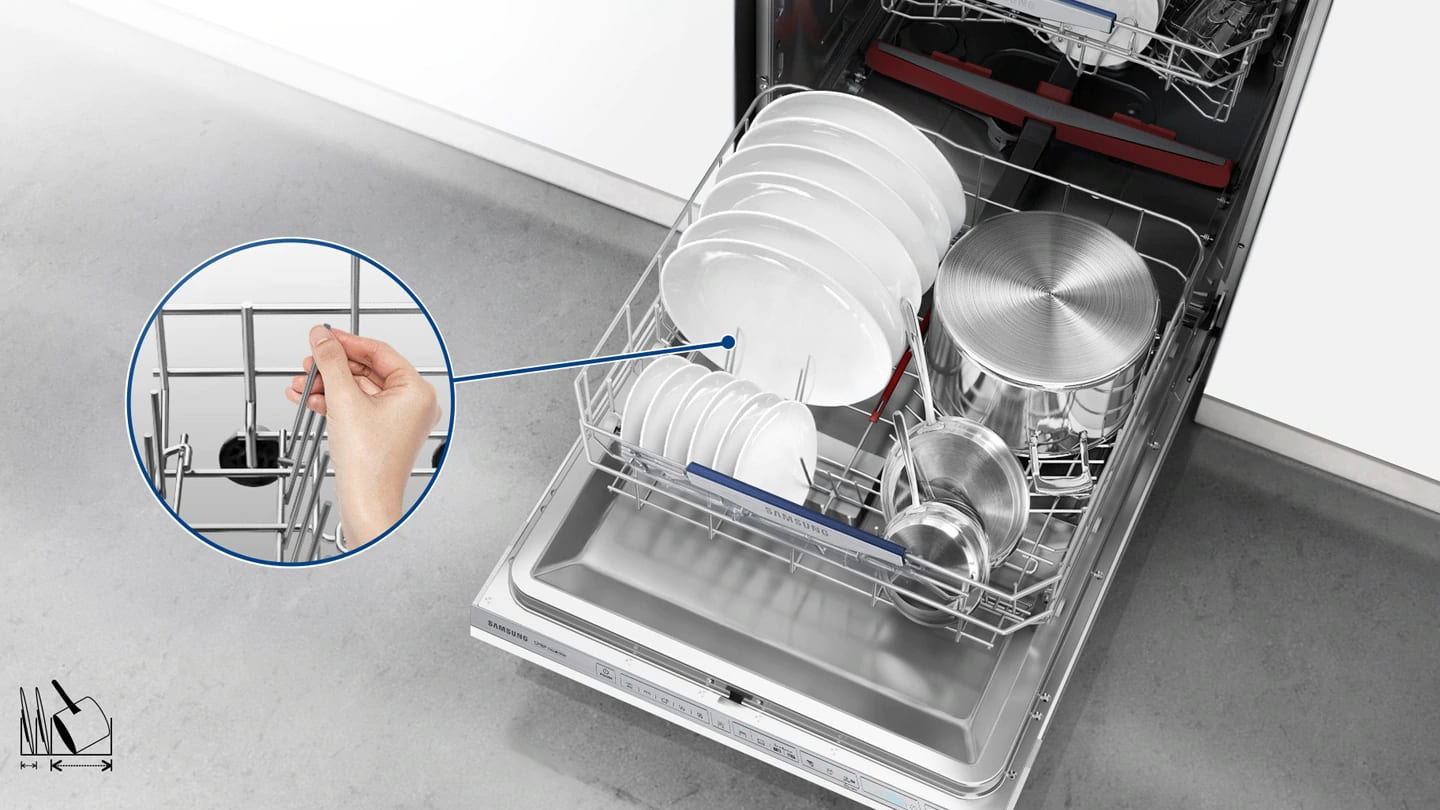
The basket begins to be filled from the lowest compartment. You need to place the largest and heaviest dishes there: pots, pans, something large. It is important that when filling, there is free space between the dishes for access and drainage of water.
The dishes must not obstruct the spray arms. If you place it at an angle, the drainage of water will be easier. Before loading dishes into the machine, be sure to remove large food residues from them under regular running water. This will help prevent filters from clogging and contribute to long service life of the equipment. Plastic dishes that can be damaged by the heating element are placed in the upper compartment of the machine.
All light utensils fit there. Spoons and forks are placed in a separate tray. Sharp objects and cutting boards are not washed in the dishwasher, so as not to damage both the equipment and the dishes themselves.
Rules for the care and operation of the dishwasher
In order for your dishwasher to serve you for a long time and efficiently, it is important to follow a number of simple rules:
- Do not perform maintenance or inspection of equipment with wet hands.
- To ensure that your equipment lasts longer, do not use adapters or extensions.
- Do not touch the device with dirty hands.
- Do not allow foreign objects to get into the machine.
- Regularly clean the PMM from grease and dirt, clean the filters from contamination.
- Get rid of excess detergent in the compartments; it is preferable to use fresh detergent each time rather than left over from previous use.
Conclusion
The dishwasher is an indispensable assistant in the kitchen. For its proper functioning, it is important to carry out maintenance on time, monitor the serviceability of components, and maintain cleanliness. Then it will delight you with clean dishes and proper functioning for a long time. Although the first start may seem daunting and there are many factors to keep in mind for the machine to function properly, over time you will get used to it and it will become part of your daily routine.






